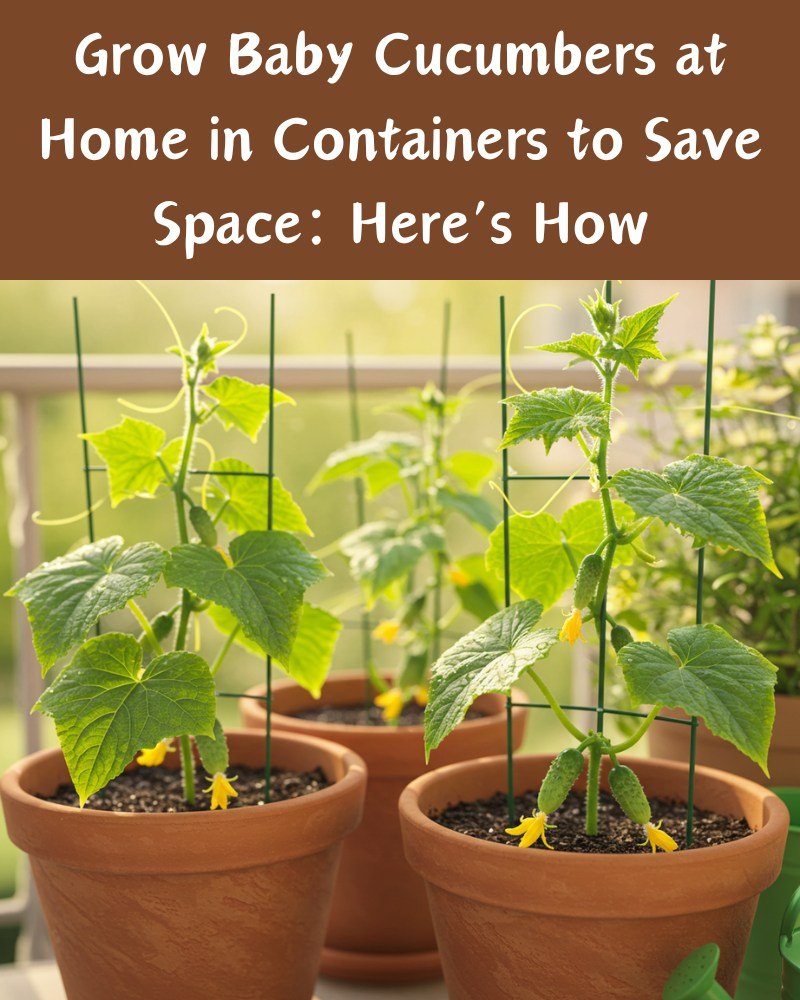Growing your own vegetables at home is a rewarding experience, and cucumbers are a fantastic choice for beginners and seasoned gardeners alike. Baby cucumbers, in particular, are a delightful addition to salads, snacks, and even pickling recipes. The best part? You don’t need a large garden to grow them. With the right techniques, you can grow baby cucumbers in containers, saving space while enjoying a bountiful harvest. In this guide, we’ll walk you through everything you need to know to grow baby cucumbers at home in containers.
Why Grow Baby Cucumbers in Containers?
Container gardening is an excellent solution for urban dwellers, apartment residents, or anyone with limited outdoor space. Here are some reasons why growing baby cucumbers in containers is a great idea:
- Space Efficiency: Containers allow you to grow cucumbers vertically, maximizing space.
- Control Over Soil and Nutrients: You can tailor the soil mix and nutrients to suit your plants’ needs.
- Pest Management: Containers make it easier to monitor and control pests.
- Portability: You can move containers to optimize sunlight exposure or protect plants from harsh weather.
- Faster Harvest: Baby cucumbers mature quicker than full-sized varieties, giving you a faster harvest.
Choosing the Right Container
The first step to growing baby cucumbers is selecting the right container. Here’s what to consider:
- Size: Choose a container that is at least 12 inches deep and 12-18 inches wide. Cucumbers have extensive root systems, so bigger is better.
- Material: Plastic, ceramic, or fabric pots are all suitable. Ensure the container has proper drainage holes to prevent waterlogging.
- Vertical Support: Since cucumbers are vining plants, opt for containers that can accommodate trellises or stakes for vertical growth.
Selecting the Perfect Baby Cucumber Variety
Not all cucumber varieties are suited for container gardening. Look for compact or bush varieties that are specifically bred for small spaces. Some excellent choices include:
- Bush Pickle: A compact variety perfect for containers, producing small, crunchy cucumbers.
- Patio Snacker: Designed for small spaces, this variety yields sweet, bite-sized cucumbers.
- Spacemaster: A popular choice for container gardening, known for its high yield and compact growth habit.
Step-by-Step Guide to Growing Baby Cucumbers in Containers
1. Prepare the Container
- Fill your container with a high-quality potting mix enriched with compost or organic matter. Cucumbers thrive in well-draining, nutrient-rich soil.
- Add a slow-release fertilizer to provide essential nutrients throughout the growing season.
2. Planting the Seeds or Seedlings
- Seeds: Plant 2-3 seeds about 1 inch deep in the center of the container. Once they sprout, thin them to the strongest seedling.
- Seedlings: If starting with seedlings, transplant them carefully into the container, ensuring the roots are well-covered with soil.
3. Provide Vertical Support
- Install a trellis, stake, or cage in the container to support the vines. This encourages upward growth, saves space, and improves air circulation.
4. Watering
- Cucumbers need consistent moisture to thrive. Water the plants deeply whenever the top inch of soil feels dry. Avoid overwatering, as this can lead to root rot.
5. Sunlight
- Place the container in a location that receives at least 6-8 hours of direct sunlight daily. Cucumbers are sun-loving plants and need ample light to produce a good harvest.
6. Fertilizing
- Feed your cucumber plants every 2-3 weeks with a balanced liquid fertilizer. This ensures they receive the nutrients needed for healthy growth and fruit production.
7. Pest and Disease Management
- Keep an eye out for common pests like aphids, cucumber beetles, and spider mites. Use organic pest control methods such as neem oil or insecticidal soap.
- Prevent fungal diseases by avoiding overhead watering and ensuring good air circulation around the plants.
8. Harvesting Baby Cucumbers
- Baby cucumbers are typically ready to harvest 50-60 days after planting. Pick them when they are 3-6 inches long for the best flavor and texture.
- Regular harvesting encourages the plant to produce more cucumbers, so check your plants daily once they start fruiting.
Tips for Success
- Mulch: Add a layer of mulch around the base of the plant to retain moisture and regulate soil temperature.
- Companion Planting: Grow companion plants like marigolds or nasturtiums in nearby containers to deter pests.
- Pruning: Remove any yellow or damaged leaves to promote healthy growth and prevent disease.
- Pollination: If growing indoors or in a sheltered area, you may need to hand-pollinate the flowers using a small brush.
Benefits of Growing Baby Cucumbers at Home
- Freshness: Homegrown baby cucumbers are fresher and more flavorful than store-bought ones.
- Cost-Effective: Growing your own cucumbers saves money in the long run.
- Sustainability: Reduce your carbon footprint by growing food at home.
- Health Benefits: Cucumbers are low in calories and rich in vitamins, minerals, and antioxidants.
Conclusion
Growing baby cucumbers in containers is a simple, space-saving way to enjoy fresh, homegrown produce. With the right container, variety, and care, you can harvest a steady supply of crunchy, delicious cucumbers right from your balcony or patio. Whether you’re a gardening novice or an experienced green thumb, this project is sure to bring joy and satisfaction. So, grab your container, seeds, and gardening tools, and get ready to grow your own baby cucumbers at home!



